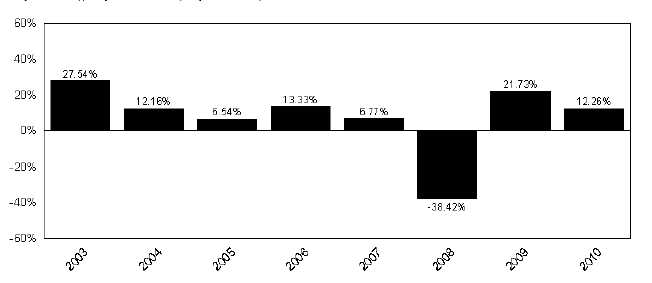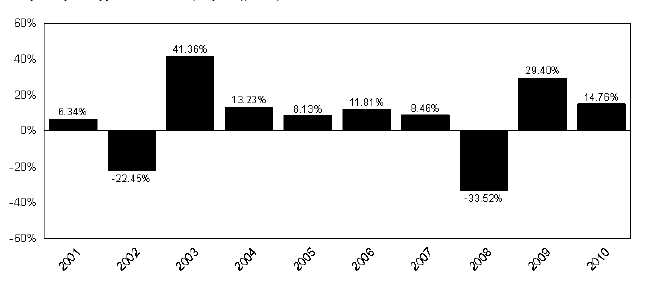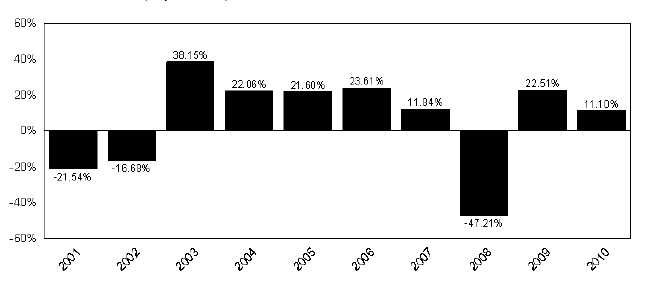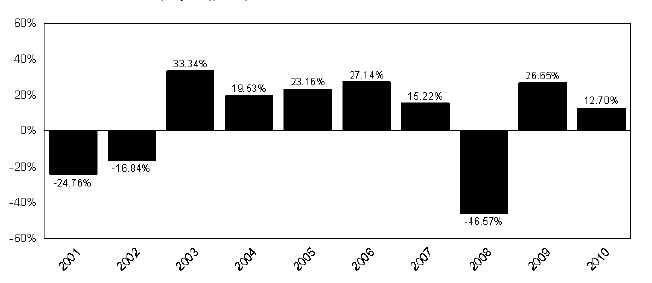| |
| Equity Securities. Equity securities include common stocks, convertible securities, depositary receipts, rights (a right is an offering of |
| common stock to investors who currently own shares which entitle them to buy subsequent issues at a discount from the offering price), and |
| warrants (a warrant is a certificate granting its owner the right to purchase securities from the issuer at a specified price, normally higher than |
| the current market price). Common stocks, the most familiar type, represent an equity (ownership) interest in a corporation. The value of a |
| company's stock may fall as a result of factors directly relating to that company, such as decisions made by its management or lower demand |
| for the company's products or services. A stock's value may also fall because of factors affecting not just the company, but also companies in |
| the same industry or in a number of different industries, such as increases in production costs. The value of a company's stock may also be |
| affected by changes in financial markets that are relatively unrelated to the company or its industry, such as changes in interest rates or |
| currency exchange rates. In addition, a company's stock generally pays dividends only after the company invests in its own business and |
| makes required payments to holders of its bonds and other debt. For this reason, the value of a company's stock will usually react more |
| strongly than its bonds and other debt to actual or perceived changes in the company's financial condition or prospects. Some of the Funds |
| focus their investments on certain market capitalization ranges. Market capitalization is defined as total current market value of a company's |
| outstanding equity securities. The market capitalization of companies in the Funds' portfolios and their related indexes will change over time |
| and, the Funds will not automatically sell a security just because it falls outside of the market capitalization range of their indexes. Stocks of |
| smaller companies may be more vulnerable to adverse developments than those of larger companies. |
| |
| Management Risk. If a Sub-Advisor's investment strategies do not perform as expected, the Fund could underperform other funds with |
| similar investment objectives or lose money. |
| • | Active Management: The performance of a Fund that is actively managed will reflect in part the ability of PMC or Sub-Advisor(s) |
| | to make investment decisions that are suited to achieving the Fund's investment objective. Funds that are actively managed are |
| | prepared to invest in securities, sectors, or industries differently from the benchmark. |
| • | Passive Management: Index funds use a passive, or indexing, investment approach. Index funds do not attempt to manage market |
| | volatility, use defensive strategies or reduce the effect of any long-term periods of poor stock or bond performance. Index funds |
| | attempt to replicate their relevant target index by investing primarily in the securities held by the index in approximately the same |
| | proportion of the weightings in the index. However, because of the difficulty of executing some relatively small securities trades, |
| | such funds may not always be invested in the less heavily weighted securities held by the index. An index fund's ability to match |
| | the performance of their relevant index may affected by many factors, such as fund expenses, the timing of cash flows into and out |
| | of the fund, changes in securities markets, and changes in the composition of the index. |
| |
| Liquidity Risk. A fund is exposed to liquidity risk when trading volume, lack of a market maker, or legal restrictions impair the fund's |
| ability to sell particular securities or close derivative positions at an advantageous price. Funds with principal investment strategies that |
| involve securities of companies with smaller market capitalizations, foreign securities, derivatives, or securities with substantial market |
| and/or credit risk tend to have the greatest exposure to liquidity risk. |
| |
| Repurchase Agreements. Repurchase agreements typically involve the purchase of debt securities from a financial institution such as a |
| bank, savings and loan association, or broker-dealer. A repurchase agreement provides that the Fund sells back to the seller and that the seller |
| repurchases the underlying securities at a specified price on a specific date. Repurchase agreements may be viewed as loans by a Fund |
| collateralized by the underlying securities. This arrangement results in a fixed rate of return that is not subject to market fluctuation while the |
| Fund holds the security. In the event of a default or bankruptcy by a selling financial institution, the affected Fund bears a risk of loss. To |
| minimize such risks, the Fund enters into repurchase agreements only with parties a Sub-Advisor deems creditworthy (those that are large, |
| well-capitalized and well-established financial institutions). In addition, the value of the securities collateralizing the repurchase agreement is, |
| and during the entire term of the repurchase agreement remains, at least equal to the repurchase price, including accrued interest. |
| |
| Real Estate Investment Trusts. Real estate investment trust securities ("REITs") involve certain unique risks in addition to those risks |
| associated with investing in the real estate industry in general (such as possible declines in the value of real estate, lack of availability of |
| mortgage funds, or extended vacancies of property). REITs are characterized as: equity REITs, which primarily own property and generate |
| revenue from rental income; mortgage REITs, which invest in real estate mortgages; and hybrid REITs, which combine the characteristics of |
| both equity and mortgage REITs. Equity REITs may be affected by changes in the value of the underlying property owned by the REITs, |
| while mortgage REITs may be affected by the quality of any credit extended. REITs are dependent upon management skills, are not |
| diversified, and are subject to heavy cash flow dependency, risks of default by borrowers, and self-liquidation. As an investor in a REIT, the |
| Fund will be subject to the REITs expenses, including management fees, and will remain subject to the Fund's advisory fees with respect to |
| the assets so invested. REITs are also subject to the possibilities of failing to qualify for the special tax treatment accorded REITs under the |
| Internal Revenue Code, and failing to maintain their exemptions from registration under the 1940 Act. |
| |
| Investment in REITs involves risks similar to those associated with investing in small capitalization companies. REITs may have limited |
| financial resources, may trade less frequently and in a limited volume, and may be subject to more abrupt or erratic price movements than |
| larger company securities. |
| |
| Derivatives. Generally, a derivative is a financial arrangement, the value of which is derived from, or based on, a traditional security, |
| asset, or market index. Certain derivative securities are described more accurately as index/structured securities. Index/structured securities |
| are derivative securities whose value or performance is linked to other equity securities (such as depositary receipts), currencies, interest |
| rates, indices, or other financial indicators (reference indices). |
| |
| There are many different types of derivatives and many different ways to use them. Futures, forward contracts, and options are |
| commonly used for traditional hedging purposes to attempt to protect a Fund from exposure to changing interest rates, securities prices, or |
| currency exchange rates and as a low-cost method of gaining exposure to a particular securities market without investing directly in those |
| securities. The Funds may enter into put or call options, futures contracts, options on futures contracts, over-the-counter swap contracts (e.g., |
| interest rate swaps, total return swaps and credit default swaps), currency futures contracts and options, options on currencies, and forward |
| currency contracts for both hedging and non-hedging purposes. A forward currency contract involves a privately negotiated obligation to |




